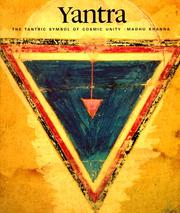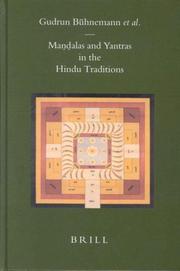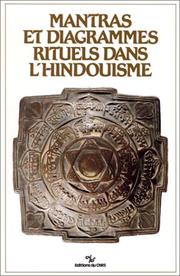| Listing 1 - 6 of 6 |
Sort by
|
Book
ISBN: 9789069800592 9069800594 9789004652910 9004652914 Year: 1994 Publisher: Leiden : BRILL,
Abstract | Keywords | Export | Availability | Bookmark
 Loading...
Loading...Choose an application
- Reference Manager
- EndNote
- RefWorks (Direct export to RefWorks)
The Kubjikāmatatantra in its Kulālikāmnāya version represents the primary literary source for the cult of the Hindu goddess Kubjikā. Three out of its twenty-five chapters, that is chapters 14-16, are devoted to a discussion of five cakras forming a system hitherto unknown. These five cakras are the seat of a great number of goddesses - called the Devīs, the Dūtīs, the Mātṛs, the Yoginīs and the Khecarīs, respectively - and, to a lesser degree, of male deities as well. Heilijgers' study presents a detailed examination of the esoteric doctrine concerning these cakras. After an introduction and a chapter on some general features of the flve cakras, each of the next five chapters deals with one separate cakra, discussing its presiding deities, its location in the human body and its symbolism. The second part contains the Sanskrit text of chapters 14-16 of the Kubjikāmatatantra, the annotated translation of these chapters and some appendices. The book offers a valuable contribution to a more thorough understanding of and insight into the Kubjikā doctrine, which occupies an important position within the Śakta oriented Hindu Tantric tradition.
Chakra (Hinduism) --- Yantras --- Yantras.

ISBN: 0500272344 Year: 1994 Publisher: London : Thames and Hudson,
Abstract | Keywords | Export | Availability | Bookmark

ISBN: 9789004492370 9789004129023 Year: 2003 Publisher: Leiden;Boston BRILL
Abstract | Keywords | Export | Availability | Bookmark
 Loading...
Loading...Choose an application
- Reference Manager
- EndNote
- RefWorks (Direct export to RefWorks)
In recent years maṇḍalas have attracted much interest among a wider public. The main focus of such interest has been directed toward Tibetan maṇḍalas, specimens of which have been included in numerous publications. But maṇḍalas are found across a wide spectrum of South Asian religious traditions, including those of the Hindus and Jains. Hindu maṇḍalas and yantras have hardly been researched. This book attempts to fill this gap by clarifying important aspects of maṇḍalas and yantras in specific Hindu traditions through investigations by renowned specialists in the field. Its chapters explore maṇḍalas and yantras in the Smārta, Pāñcarātra, Śaiva and Śākta traditions. An essay on the vāstupuruṣamaṇḍala and its relationship to architecture is also included. With 13 colour plates.
Hindu symbolism --- Mandala --- Yantras
Book
ISBN: 9004652914 9069800594 Year: 1994 Publisher: Leiden : BRILL,
Abstract | Keywords | Export | Availability | Bookmark
 Loading...
Loading...Choose an application
- Reference Manager
- EndNote
- RefWorks (Direct export to RefWorks)
The Kubjikāmatatantra in its Kulālikāmnāya version represents the primary literary source for the cult of the Hindu goddess Kubjikā. Three out of its twenty-five chapters, that is chapters 14-16, are devoted to a discussion of five cakras forming a system hitherto unknown. These five cakras are the seat of a great number of goddesses - called the Devīs, the Dūtīs, the Mātṛs, the Yoginīs and the Khecarīs, respectively - and, to a lesser degree, of male deities as well. Heilijgers' study presents a detailed examination of the esoteric doctrine concerning these cakras. After an introduction and a chapter on some general features of the flve cakras, each of the next five chapters deals with one separate cakra, discussing its presiding deities, its location in the human body and its symbolism. The second part contains the Sanskrit text of chapters 14-16 of the Kubjikāmatatantra, the annotated translation of these chapters and some appendices. The book offers a valuable contribution to a more thorough understanding of and insight into the Kubjikā doctrine, which occupies an important position within the Śakta oriented Hindu Tantric tradition.
Book
ISBN: 9004647139 Year: 1966 Publisher: Leiden ; Boston : Brill,
Abstract | Keywords | Export | Availability | Bookmark
 Loading...
Loading...Choose an application
- Reference Manager
- EndNote
- RefWorks (Direct export to RefWorks)
The author asks to what extent a knowledge of the concepts of yoga may prepare the way to a better understanding of Indian archaeology. The yoga at the basis of this study is that which forms the core of the Tantras . In the first chapter the author surveys the system of Tantrik yoga. He then continues with a discussion of the various forms of yantras , that is all the means employed by yogis in their meditational exercises as aids to the concentration of thought. The author provides in-depth studies of ritual objects of the Lamaistic cult in Tibet and Nepal, the sacred cemeteries of Nepal, and pantheons in Java and Bali. See Less
Buddhist antiquities. --- Buddhist art and symbolism. --- Hindu antiquities. --- Hindu symbolism. --- Yantras. --- Yoga. --- Buddhist antiquities. --- Buddhist art and symbolism. --- Hindu antiquities. --- Hindu symbolism. --- Yantras. --- Yoga.

ISBN: 2222038499 9782222038498 Year: 1986 Publisher: [Lieu de publication inconnu]: [éditeur inconnu],
Abstract | Keywords | Export | Availability | Bookmark
 Loading...
Loading...Choose an application
- Reference Manager
- EndNote
- RefWorks (Direct export to RefWorks)
294.137 --- Mantras --- -Yantras --- -Hindu symbolism --- -Symbolism --- Amulets (Hinduism) --- Hindu symbolism --- Tantrism --- Incantations --- Symboliek van de Hindoe-godsdiensten --- Congresses --- Yantras --- Congresses. --- -Symboliek van de Hindoe-godsdiensten --- 294.137 Symboliek van de Hindoe-godsdiensten --- -294.137 Symboliek van de Hindoe-godsdiensten --- Symbolism --- Hindouisme. Rites. (Congrès) --- Hindoeisme. Riten. (Congres)
| Listing 1 - 6 of 6 |
Sort by
|

 Search
Search Feedback
Feedback About UniCat
About UniCat  Help
Help News
News